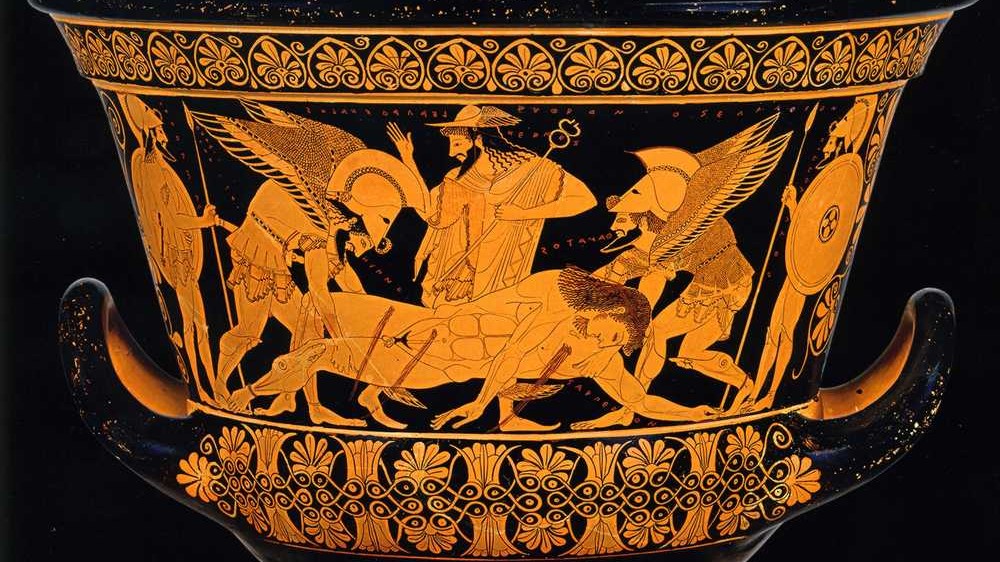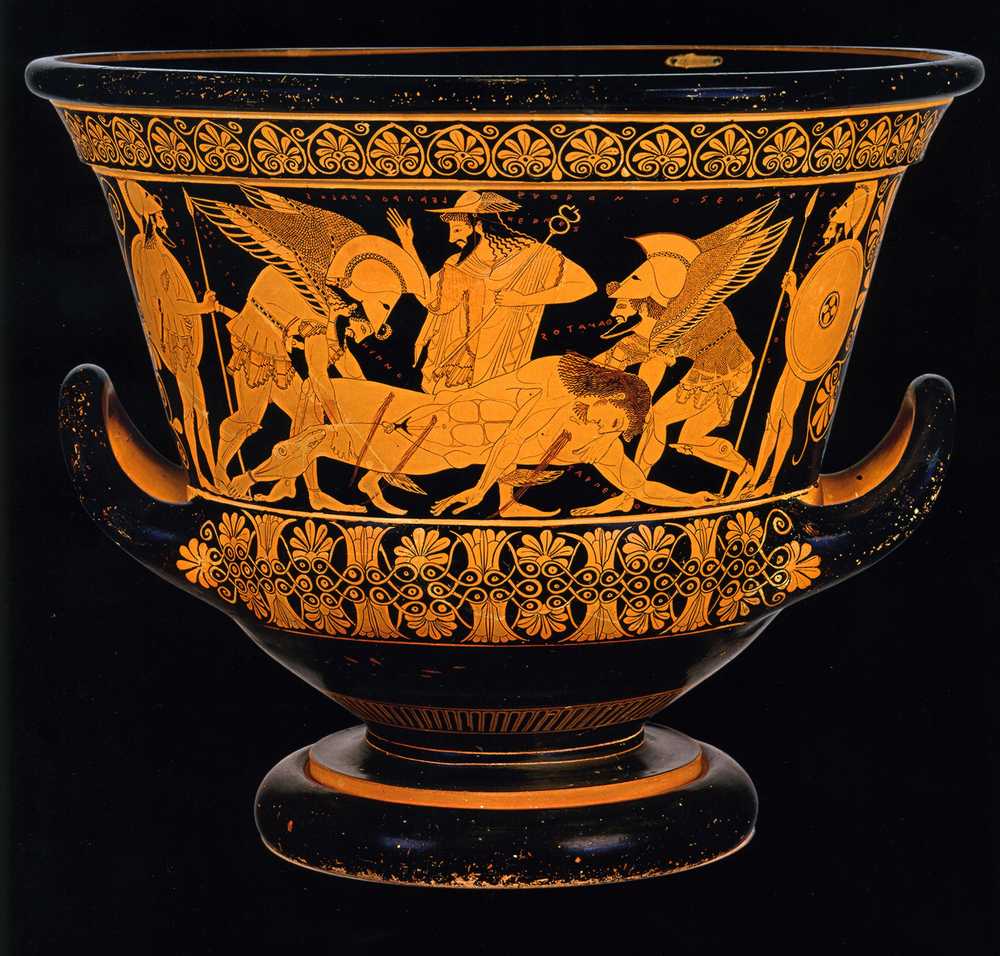History, Holidays & Observances on January 18
Holidays & Observances: Royal Thai Armed Forces Day, Amy Carmichael
Major Events: War of the Roses, 1st Jewish Uprising in the Warsaw Ghetto
Notable Events: Pope Pius IV, Henry Morgan takes Panama, Frederick I crowned King of Prussia, James Cook discovers the Hawaiian Islands, Britain’s Penal transportation, Boston Strangler, Marion Barry, the Euphronios Krater,
Born: Oliver Hardy, Cary Grant, Danny Kaye, Carroll Cloar
Died: Rudyard Kipling
Holidays and Observances on January 18
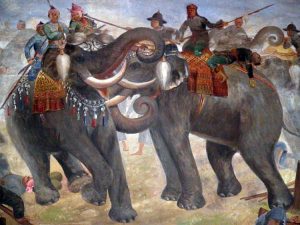 Royal Thai Armed Forces Day: According to Thai folklore, on this day, the armies of Siam and Burma met in combat. During battle, the King of Siam, Naresuan, challenged the Burgmese general, Crown Prince Mingyi Swa, to single combat. Both were mounted upon elephants and their duel is known in folklore as the the Elephant Battle:
Royal Thai Armed Forces Day: According to Thai folklore, on this day, the armies of Siam and Burma met in combat. During battle, the King of Siam, Naresuan, challenged the Burgmese general, Crown Prince Mingyi Swa, to single combat. Both were mounted upon elephants and their duel is known in folklore as the the Elephant Battle:
The Burmese prince was younger, fitter and had a better trained elephant, and Naresuan came close to suffering a fatal blow, escaping with just a cut on his face, but soon had the upper hand. He caught Mingya Swa off guard, and struck him with a blow which, according to some accounts, saw him cut in half from his right shoulder down to his left hip. The Burmese surrendered following the defeat of their prince, and the battle was over; Ayutthaya had once more repelled the mighty Burmese armies. The king built a pagoda on the spot where he was victorious, and his ngaw — the type of blade he used to kill the prince — and helmet were housed in it.
Memorial to Amy Carmichael – an Anglican missionary who spent her adult life in India between 1900 and 1951. Carmichael opened an orphanage and mission in Dohnavur and spent her life rescuing young girls from sexual slavery. At the time, Hindu temple children were primarily young girls dedicated to the gods, then usually forced into prostitution to earn money for the priests. Families often sold their children to the temples if they did not want them, or could not support them. During Carmichael’s lifetime, her Dohnavur mission grew into a sanctuary for over one thousand children who would otherwise have faced a bleak future.
Major Events on January 18
1486 – Wars of the Roses: King Henry VII of England marries Elizabeth of York
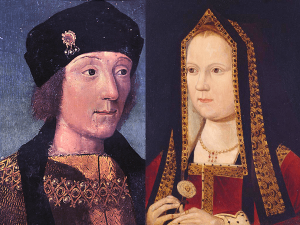 The Wars of the Roses was a series of English civil wars fought for the Crown of England between the House of York and the House of Tudor. The wars, beginning in 1455, lasted over three decades, until finally put to rest by King Henry VII.
The Wars of the Roses was a series of English civil wars fought for the Crown of England between the House of York and the House of Tudor. The wars, beginning in 1455, lasted over three decades, until finally put to rest by King Henry VII.
On the battlefield, Henry VII defeated and killed the final York claimant, Richard III at the Battle of Bosworth Field in 1485. Henry then assumed the throne as Henry VII.
On this day in 1486, Henry put the next to last nail in the coffin of the Wars of the Roses by marrying Elizabeth of York, the niece of Richard III, thereby uniting the two claims.
In 1487, the final act of the war played out when a Yorkist sympathizer, the Earl of Lincoln, put forward an impostor, claiming him to be Edward Plantagenet, rightful heir to the throne. Lincoln’s forces were defeated, and he was killed at the Battle of Stoke Field on 16 June 1487, bringing a close to the Wars of the Roses.
[T]he many casualties among the nobility continued the changes in feudal English society caused by the effects of the Black Death. These included a weakening of the feudal power of the nobles and an increase in the power of the merchant classes and the growth of a centralised monarchy under the Tudors. The wars heralded the end of the medieval period in England and the movement towards the Renaissance. After the wars, the large standing baronial armies that had helped fuel the conflict were suppressed. Henry VII, wary of any further fighting, kept the barons on a very tight leash, removing their right to raise, arm and supply armies of retainers so that they could not make war on each other or the king. The military power of individual barons declined, and the Tudor court became a place where baronial squabbles were decided with the influence of the monarch.
1943 – The Holocaust: The first uprising of Jews in the Warsaw Ghetto
According to the Holocaust Encyclopedia:
The Nazis . . . used the term “Final Solution” to refer to their plan to annihilate the Jewish people. It is not known when the leaders of Nazi Germany definitively decided to implement the “Final Solution.” The genocide, or mass destruction, of the Jews was the culmination of a decade of increasingly severe discriminatory measures.
By 1942, the Nazis were implementing the “Final Solution” to exterminate the Jews. Pre-WW II Poland had a large population of Jews, over three million, concentrated in ghettos in several large cities. The largest concentration was in Warsaw, where some 400,000 Jews resided in an area of 1.3 sq. miles.
The SS targeted Operation Grossaktion Warschau at the Warsaw Ghetto in the summer of 1942. In July, the German “Resettlement Commissioner” Hermann Höfle called a meeting of the Ghetto Jewish Council and informed them that he would require 7,000 Jews a day for the “resettlement to the East.” The Jews, believing that they would be transported to labor camps, complied peacefully. In reality, they were being transported fifty miles to their death at the Treblinka extermination camp.
Within months, the Jews became aware of the truth of their situation. By then, there were only 50,000 Jews remaining in the Warsaw Ghetto. With nothing to lose, the Jews decided to revolt, with the first armed resistance coming on this date in 1943, as the Nazi’s entered the Warsaw ghetto to began a new round up of Jews.
While Jewish families hid in their so-called “bunkers”, fighters . . . resisted, engaging the Germans in direct clashes. Though [they] . . . suffered heavy losses (including some of their leaders), the Germans also took casualties, and the deportation was halted within a few days. Only 5,000 Jews were removed, instead of the 8,000 planned by Globocnik. Hundreds of people in the Warsaw Ghetto were ready to fight, adults and children, sparsely armed with handguns, gasoline bottles, and a few other weapons that had been smuggled into the ghetto by resistance fighters. Most of the Jewish fighters did not view their actions as an effective measure by which to save themselves, but rather as a battle for the honour of the Jewish people, and a protest against the world’s silence.
The SS did not enter the Warsaw Ghetto again until April 1943, on the eve of Passover.
Notable Events on January 18
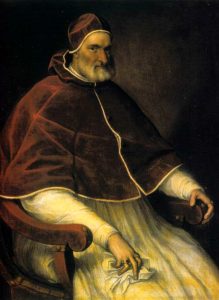 1562 – Pope Pius IV reopens the Council of Trent for its third and final session. When it became clear that there would be no reconciliation with the various Protestant groups, the Council of Trent came to embody the counter-Reformation.
1562 – Pope Pius IV reopens the Council of Trent for its third and final session. When it became clear that there would be no reconciliation with the various Protestant groups, the Council of Trent came to embody the counter-Reformation.
1670 – Sir Henry Morgan, who acted as the Lt. Governor and sometimes even Governor of Jamaica when he wasn’t leading pirate raids on the Spanish, on this day, captured Panama City in Panama.
The battle was a rout, although the privateers profited less than in other raids. To appease the Spanish, with whom the English had signed a peace treaty, Morgan was arrested and summoned to London in 1672, but was treated as a hero by the general populace and the leading figures of government and royalty including Charles II.
Britain, after duly winking and nodding at Henry Morgan, returned him to Jamaica to resume his activities for King and country.
1701 – Frederick I crowns himself King of Prussia in Königsberg. He loved French food, much of French culture, but hated the French. He would have made a good Englishman. Regardless, his diplomacy, to convince Archduke of Austria to recognize Prussia as a Kingdom, set the stage for his more famous grandson, Frederick the Great, four decades later.
1778 – The great British explorer, Captain James Cook, discovered the Hawaiian Islands on this date. He named them the “Sandwich Islands” in honor of the most debauched man in British politics of the era (and that is saying much), the Earl of Sandwich, then the First Lord of the Admiralty. Cooks explorations came to an end in the next year when was attacked and killed while attempting to kidnap the Island of Hawaii’s monarch, Kalaniʻōpuʻu, in order to reclaim a cutter stolen from one of his ships.
1788 – The first elements of the First Fleet carrying 736 convicts from Great Britain to Australia arrive at Botany Bay. Much is made out of Britain’s transport of prisoners to Australia, but that was only because the American colonies were finally foreclosed. From the Transportation Act in 1717 until 1775, Britain routinely emptied their prisons into the American colonies. In 1751, Ben Franklin suggested that the colonists show their appreciation by sending rattlesnakes to Parliament.
1967 – Albert DeSalvo, the “Boston Strangler”, believed to have committed thirteen rapes and murders between 1962 and 1964, is convicted on this date and sentenced to life imprisonment. In 1973, he was stabbed to death in prison.
1990 – Washington, D.C. Mayor Marion Barry is arrested for drug possession in an FBI sting. This led to David Letterman’s Top Ten campaign slogans for the Mayor:
10. I’m addicted – to public service.
9. America’s Funniest Home Video.
8. Just Say Yes.
7. I’m a Kennedy.
6. He’s ready to personally confiscate drugs.
5. Let’s put a little Colombia into the District of Columbia.
4. Hey—-here’s your Justice Department, pal!
3. He’ll get the hookers off the streets—-and into the hotel rooms.
2. Imagine the victory party!
1. I’m Barry, Barry sorry.
2008 – The Euphronios Krater, is unveiled on this date in Rome after being returned to Italy by the Metropolitan Museum of Art. The Krater is an ancient Greek terra cotta bowl dating to 515 BC. It is the only complete example of the surviving 27 vases painted by the renowned Euphronios and is considered one of the finest Greek vase artifacts in existence.
Born on January 18
1892 – Oliver Hardy, who, with Stan Laurel, formed one of the most popular comedy teams in the first half of the 20th century. Between 1921 and their last appearance in 1950, They appeared as a team in 107 films, starring in 32 short silent films, 40 short sound films, and 23 full-length feature films.
https://youtu.be/n4XwHoJ96W4
1904 – Cary Grant, the English born American actor who for decades was classic Hollywood’s definitive leading men. He was known for his transatlantic accent, debonair demeanor, light-hearted approach to acting, and sense of comic timing. Over his lifetime, Grant starred in over 70 movies until his retirement in 1966, playing comedic roles as easily as he played dramatic roles. Despite his immense popularity, he never won a competitive Oscar. One of my own favorites is “Bringing Up Baby” in 1938.
1911 – Danny Kaye, a good natured singer and actor often associated with clownish roles, or as Ms. BWR says, putting on her critic’s hat, Kaye is famous for his nonsense patter and his characters’ ability to triumph over his own manifest failings. By her choice, this is her favorite scene from the Court Jester:
1913 – Carroll Cloar, a well known artist of the 20th century, but like most 20th century artists, not to my tastes. Below is a work from 1960, Halloween, currently on display at the Memphis Brooks Museum of Art.
Died on January 18
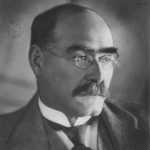 1936 – Rudyard Kipling, Britain’s most famous author and poet at the turn of the 20th century. I recently posted two of his poems, If and Gods of the Copybook Headings, here. But there is always room for more:
1936 – Rudyard Kipling, Britain’s most famous author and poet at the turn of the 20th century. I recently posted two of his poems, If and Gods of the Copybook Headings, here. But there is always room for more:
I KEEP six honest serving-men
(They taught me all I knew);
Their names are What and Why and When
And How and Where and Who.
I send them over land and sea,
I send them east and west;
But after they have worked for me,
I give them all a rest.
I let them rest from nine till five,
For I am busy then,
As well as breakfast, lunch, and tea,
For they are hungry men.
But different folk have different views;
I know a person small—
She keeps ten million serving-men,
Who get no rest at all!
She sends ’em abroad on her own affairs,
From the second she opens her eyes—
One million Hows, two million Wheres,
And seven million Whys!
And now for Kipling’s most controversial poem today . . .
TAKE up the White Man’s burden –
Send forth the best ye breed –
Go bind your sons to exile
To serve your captives’ need;
To wait in heavy harness
On fluttered folk and wild –
Your new-caught sullen peoples,
Half devil and half child.
Take up the White Man’s burden –
In patience to abide
To veil the threat of terror
And check the show of pride;
By open speech and simple,
An hundred times made plain,
To seek another’s profit,
And work another’s gain.
Take up the White Man’s burden –
The savage wars of peace –
Fill full the mouth of famine
And bid the sickness cease;
And when your goal is nearest
The end for others sought,
Watch Sloth and heathen Folly
Bring all your hopes to nought.
Take up the White Man’s burden –
No tawdry rule of kings,
But toil of serf and sweeper –
The tale of common things.
The ports ye shall not enter,
The roads ye shall not tread,
Go make them with your living,
And mark them with your dead !
Take up the White Man’s burden –
And reap his old reward,
The blame of those ye better,
The hate of those ye guard –
The cry of hosts ye humour
(Ah slowly !) towards the light:-
“Why brought ye us from bondage,
“Our loved Egyptian night ?”
Take up the White Man’s burden –
Ye dare not stoop to less –
Nor call too loud on Freedom
To cloak your weariness;
By all ye cry or whisper,
By all ye leave or do,
The silent sullen peoples
Shall weigh your Gods and you.
Take up the White Man’s burden –
Have done with childish days –
The lightly proffered laurel,
The easy, ungrudged praise.
Comes now, to search your manhood
Through all the thankless years,
Cold-edged with dear-bought wisdom,
The judgement of your peers
– For the background on this poem, see here.
